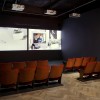The Fruitmarket gallery in Edinburgh is a gem of a venue for contemporary visual art in the city. Nestled in beside Waverley train station and facing the City Arts Centre, in the last twelve months the gallery has staged exhibitions by David Batchelor, Massimo Bartolini and Dieter Roth, with a back catalogue that includes Eva Hesse in 2009 and Martin Creed in 2010.
Part of the International Art Festival, Gabriel Orozco’s Thinking in Circles, has run since 1 August 2013. Having spent weeks in anticipation of seeing first-hand the work of an artist I admire, I couldn’t help but feel somewhat deflated when I walked into the ground floor gallery space and realised that I had in fact already visited the exhibition, but had completely forgotten. Given that it is a fantastic insight into how an artist may explore a single subject as a larger part of their processes and development, this was difficult to understand.
Thinking in Circles is curated by Briony Fer, and does more or less what the title suggests. Using found objects, inks, photographs, body parts and a number of other materials and techniques, Orozco has explored the many ways in which circles and spheres can be used in and created as visual art, including a series of paintings on acetate from the 1990s and an incised soccer ball from 2009. Both figuratively and literally, the exhibition spans from the painting responsible for its concept: The Eye of Go (2005) is situated directly opposite the door into the lower gallery and grabs the viewer’s attention as soon as they enter. What I found so appealing about the exhibition was that the work was very experimental and approachable. It is a very thorough exploration of a very simple form, with the lower gallery in particular making the viewer feel as if they are following the thought processes of Orozco as one set of artworks develops into another.
Paintings on acetate are displayed in the upper gallery, the layout of which feels much more formal. The variety of textures and materials in the lower gallery gives a more cluttered and tactile impression, whereas all the artworks upstairs are two dimensional. Although the viewer can walk around the pieces and explore the variations in light and shadow that play around them, the best effects are gleaned when the viewer stands back to observe how they impose and overlay themselves onto the gallery space. Whilst this upper gallery space has its own appeal, it almost feels a bit superfluous – I found the exhibition much more captivating than my companions did, but by the time we went upstairs even my interest was beginning to wander.
Perhaps this is why my initial impressions were not lasting; for all the appeal of Orozco’s work in this exhibition, which displays the artist’s personal curiosity and capacity for exploring a subject through multiple variations and forms, it does not contain anything that necessarily stands out and makes the viewer stop and think. There are artworks which are dynamic, intricate, and even amusing in a way, but nothing which made me stop in my tracks from sheer fascination. And those are the exhibitions and artworks which are the most memorable.











